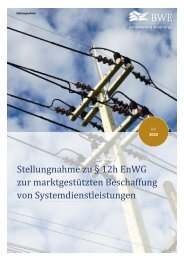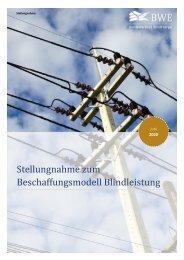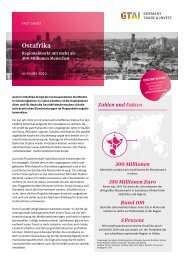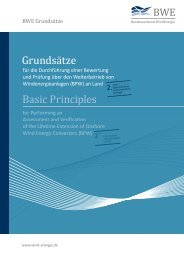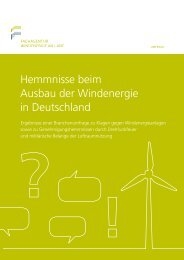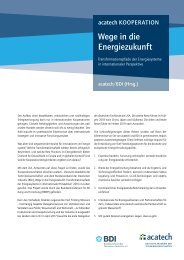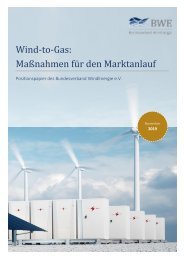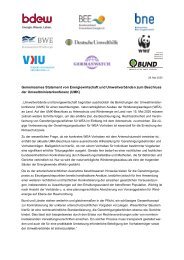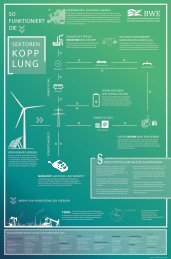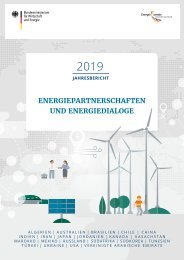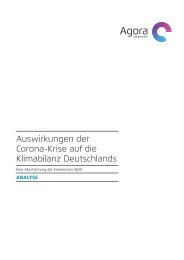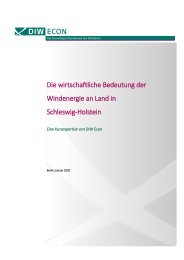vierter-monitoring-bericht-energie-der-zukunft-englische-kurzfassung
Create successful ePaper yourself
Turn your PDF publications into a flip-book with our unique Google optimized e-Paper software.
A good piece of work<br />
The Energy of the Future<br />
Fourth “Energy Transition” Monitoring Report – Summary
Imprint<br />
Publisher<br />
The Fe<strong>der</strong>al Ministry for<br />
Economic Affairs<br />
and Energy (BMWi)<br />
Public Relations<br />
11019 Berlin<br />
www.bmwi.de<br />
Fe<strong>der</strong>al Ministry for Economic Affairs<br />
and Energy (BMWi) has been awarded the<br />
berufundfamilie® audit certificate for its<br />
family-friendly HR policy. The certificate<br />
is granted by berufundfamilie gGmbH,<br />
an initiative of the Hertie Foundation.<br />
Design and production<br />
PRpetuum GmbH, Munich<br />
Status<br />
November 2015<br />
Print<br />
Silber Druck oHG, Niestetal<br />
Illustrations<br />
kreativmandat – ivone delazzerböhmer / Fotolia.com –<br />
Lulu Berlu / Fotolia.com – kflgalore / Fotolia.com – smuki /<br />
Fotolia.com – zlikovec (title), Fotolia.com – Hans Peter Denecke<br />
(p. 6), Fotolia.com – smuki (p. 8), shutterstock – Natalia Deksbakh<br />
(p. 10), Fotolia.com – sp4764 (p. 12), Fotolia.com –<br />
candy1812 (p. 14), shutterstock – Roberto Piras (p. 16),<br />
Fotolia.com – Alex Yeung (p. 18), BMWi – Maria Parussel<br />
(p. 20, 22), gettyimages – Mike Harrington (p. 24)<br />
This brochure is published as part of the public relations<br />
work of the Fe<strong>der</strong>al Ministry for Economic Affairs and Energy<br />
(BMWi). It is distributed free of charge and is not intended for<br />
sale. The distribution of this brochure at campaign events or at<br />
information stands run by poli tical parties is prohibited, and<br />
political party-related information or advertising shall not be<br />
inserted in, printed on, or affixed to this publication.<br />
This publication as well as further publications<br />
can be obtained from:<br />
Fe<strong>der</strong>al Ministry for Economic Affairs<br />
and Energy (BMWi)<br />
Public Relations<br />
E-Mail: publikationen@bundesregierung.de<br />
www.bmwi.de<br />
Central procurement service:<br />
Tel.: +49 30 182722721<br />
Fax: +49 30 18102722721
1<br />
Contents<br />
Central messages from the Fourth Monitoring Report. ..................................................................................................................................2<br />
1 Monitoring the energy transition .....................................................................................................................................................................3<br />
2 Objectives of the energy reforms .......................................................................................................................................................................4<br />
3 Renewable energy .......................................................................................................................................................................................................6<br />
4 Energy consumption and energy efficiency................................................................................................................................................8<br />
5 Buildings. ....................................................................................................................................................................................................................... 10<br />
6 Transport. ...................................................................................................................................................................................................................... 12<br />
7 Greenhouse gas emissions .................................................................................................................................................................................. 14<br />
8 Power plants and security of supply ............................................................................................................................................................. 16<br />
9 Affordable energy and a level playing field............................................................................................................................................... 18<br />
10 Grid infrastructure .................................................................................................................................................................................................. 20<br />
11 Energy research and innovation ..................................................................................................................................................................... 22<br />
12 Investment, growth and jobs............................................................................................................................................................................. 24
2<br />
Central messages from the<br />
Fourth Monitoring Report<br />
• zEnergy consumption fell by 4.7% in 2014 from the 2013<br />
level. Much of this reduction can be attributed to the<br />
mild winter of 2014. At 13,132 petajoules, energy consumption<br />
reached its lowest level since 1990.<br />
• zRenewables are Germany’s number-one source of electricity.<br />
In the first half of 2015, the proportion of electricity<br />
consumption covered by renewable energy rose<br />
above 30% for the first time. Germany is on course to<br />
meet its renewable electricity consumption targets.<br />
The level of the EEG surcharge has stabilised.<br />
• zOn average, Germany’s energy efficiency increased by<br />
an annual 1.6% between 2008 and 2014, which is less<br />
than the 2.1% envisaged by the Fe<strong>der</strong>al Government in<br />
its Energy Concept. Further action is required here. For<br />
this reason, the Fe<strong>der</strong>al Government brought together<br />
and strengthened the efforts to boost energy efficiency<br />
in the National Action Plan on Energy Efficiency<br />
adopted on 3 December 2014.<br />
• zFinal energy consumption in the transport sector was<br />
approx. 1.7% higher in 2014 than in 2005. If Germany is<br />
to attain its target of cutting final energy consumption<br />
by 10% from the 2005 figure, further efforts will be<br />
required.<br />
• zFor the first time in more than ten years, the electricity<br />
prices for household customers fell at the beginning of<br />
2015. For industrial and commercial customers not<br />
covered by special arrangements, electricity prices<br />
remained virtually constant in 2014. Trading prices for<br />
electricity were down by a further 10% last year and<br />
have continued to fall in 2015.<br />
• zIn 2014, Germany imported fossil fuels worth approx.<br />
€81 billion, down from the 2013 figure of around €95<br />
billion. Whilst much of these savings can be attributed<br />
to lower commodity prices, Germany has also cut down<br />
on the volume of these imports.
3<br />
1 Monitoring the energy transition<br />
The Energy for the Future <strong>monitoring</strong> process reviews<br />
the energy transition on an ongoing and systematic basis:<br />
Where do we stand, and what are the next steps?<br />
The focus is on three <strong>monitoring</strong> tasks:<br />
• zOverview: The <strong>monitoring</strong> process provides a fact-based<br />
overview of the current status of progress with regard to<br />
implementation of the energy reforms. It condenses the<br />
reams of statistical information on energy that have<br />
been collected into a smaller, more manageable number<br />
of selected indicators.<br />
• zEvaluation: Ongoing reports analyse whether the targets<br />
set out in the Fe<strong>der</strong>al Government’s Energy Concept<br />
are being met and what effect the measures are having.<br />
In areas where the targets are likely to be missed, measures<br />
are proposed to enable these targets to be met.<br />
The Fourth Monitoring Report documents the status of<br />
the energy transition in 2014. At the heart of the <strong>monitoring</strong><br />
process for the energy transition is the Monitoring<br />
Report, which provides new facts and figures about the<br />
energy transition.<br />
An independent commission of experts provides the<br />
Fe<strong>der</strong>al Government with advice. Working on a scientific<br />
basis, the commission comments on the Fe<strong>der</strong>al Government’s<br />
<strong>monitoring</strong> and progress reports. Prof. Dr. Andreas<br />
Löschel is the chair of the commission. Other members are<br />
Prof. Dr. Georg Erdmann, Prof. Dr. Frithjof Staiß and<br />
Dr. Hans-Joachim Ziesing.<br />
• zOutlook: The <strong>monitoring</strong> process also looks ahead to<br />
the next few years. To this end, the Fe<strong>der</strong>al Government<br />
produces summary progress reports every three years,<br />
presenting likely developments and <strong>der</strong>iving recommendations<br />
for action.
4<br />
2 Objectives of the energy reforms<br />
By pursuing the energy transition, the Fe<strong>der</strong>al Government<br />
is leading Germany towards a future with a secure,<br />
economic and environmentally compatible energy supply.<br />
The orientation for the energy transition – and thus<br />
the basis for its <strong>monitoring</strong> – is provided by the Fe<strong>der</strong>al<br />
Government’s Energy Concept, further decisions by the<br />
Bundestag, and European rules.<br />
The Monitoring Report studies the quantitative targets and<br />
the other goals and policies affecting the energy transition:<br />
The <strong>monitoring</strong> process for the energy transition is based<br />
on publicly available, verifiable data. It is un<strong>der</strong>taken<br />
using indicators which present the current status / development<br />
over time of the energy transition. The data used<br />
can be found at bmwi.de.<br />
A points system is used to assess the progress made in<br />
terms of the quantitative targets of the energy transition.<br />
Firstly, the development of the indicators since 2008 is<br />
extrapolated on a linear basis. On the basis of percentage<br />
Table: Quantitative targets of the energy transition and status quo (2014)<br />
Greenhouse gas emissions<br />
2014 2020 2030 2040 2050<br />
Greenhouse gas emissions<br />
(compared with 1990)<br />
Renewable energy<br />
-27 % at least -40 % at least -55 % at least -70 %<br />
at least<br />
-80 bis -95 %<br />
Share of gross final<br />
energy consumption<br />
13.5 % 18 % 30 % 45 % 60 %<br />
Share of gross<br />
electricity consumption<br />
27.4 % at least 35 % at least 50 %<br />
Renewable Energy<br />
Sources Act 2025:<br />
40–45 %<br />
at least 65 %<br />
Renewable Energy<br />
Sources Act 2025:<br />
55–60 %<br />
at least 80 %<br />
Share of heat consumption 12.0 % 14 %<br />
Share in transport sector 5.6 %<br />
Efficiency and consumption<br />
Primary energy consumption<br />
(compared with 2008)<br />
-8.7 % -20 % -50 %<br />
Final energy productivity<br />
(2008-2050)<br />
1.6 %/year<br />
(2008–2014)<br />
2,1 %/year (2008–2050)<br />
Gross electricity consumption<br />
(compared with 2008)<br />
Primary energy consumption in<br />
buildings (compared with 2008)<br />
Heat consumption in buildings<br />
(compared with 2008)<br />
Final energy consumption:<br />
transport (compared with 2005)<br />
-4.6 % -10 % -25 %<br />
-14.8 % -80 %<br />
-12.4 % -20 %<br />
1.7 % -10 % -40 %<br />
Source: In-house figures from the Fe<strong>der</strong>al Ministry for Economic Affairs and Energy, October 2015
2 OBJECTIVES OF THE ENERGY REFORMS 5<br />
deviations of the extrapolated figures from the target figures<br />
in 2020, points are awarded as follows for this report:<br />
5 points if the target is met or the deviation is less than<br />
10%; 4 points if the deviation is between 10 and 20%;<br />
3 points if the deviation is between 20 and 40%; 2 points<br />
if the deviation is between 40 and 60%; and 1 point if the<br />
calculated deviation exceeds 60%.<br />
The future impact of measures which are currently being<br />
implemented is not reflected in this assessment of<br />
whether targets are met. They may yet have an impact, and<br />
the actual development can deviate from the extrapolated<br />
path in response to political and economic influences.<br />
The evaluation scheme applied here cannot replace complex,<br />
model-based forecasts. But this system offers the<br />
advantage of a comparatively simple and comprehensible<br />
depiction of the current status of key energy transition<br />
variables.<br />
Table: Targets and policies affecting the energy transition<br />
Security of supply<br />
Covering Germany’s energy needs at all times.<br />
Nuclear energy phase-out Switching off the last nuclear power plants at the end of 2022.<br />
Affordability, competitiveness<br />
Grid expansion<br />
Energy research, innovation<br />
Investment, growth,<br />
employment<br />
Maintaining affordability of energy and ensuring Germany’s competitiveness.<br />
Expanding and mo<strong>der</strong>nising grids to meet demand.<br />
Fostering forward-looking innovations for the restructuring of the energy supply.<br />
Retaining jobs in Germany and laying the foundations for sustainable growth<br />
and quality of life.<br />
Source: In-house figures from the Fe<strong>der</strong>al Ministry for Economic Affairs and Energy, October 2015
6<br />
3 Renewable energy<br />
Where do we stand?<br />
Renewables are to become the mainstay of our energy<br />
supply. In 2014, the gross final energy delivered by renewable<br />
sources amounted to 335 TWh. Renewables covered<br />
13.5% of gross final energy consumption.<br />
Renewables were Germany’s number-one source of electricity<br />
in 2014. At 161 TWh, renewables accounted for<br />
27.4% of Germany’s gross electricity consumption. Onshore<br />
and offshore wind provided 9.7%, biomass 8.3% and photovoltaics<br />
6%. Overall, Germany is on course to meet its<br />
renewable electricity consumption targets. The trend seen<br />
in previous years is continued.<br />
At 12.0% in 2014, the share of renewable energy in total<br />
heat consumption is already approaching the 2020 target<br />
of 14%. Overall heat consumption dropped in 2014. This<br />
also affected the amount of heat generated by renewable<br />
energy. In 2014, the amount of heat generated from renewable<br />
sources dropped to approx. 140 TWh. Biomass remained<br />
the leading source of heat.<br />
The use of renewables in the transport sector rose mo<strong>der</strong>ately<br />
in 2014. In view of energy consumption of 36 TWh,<br />
the share of renewable energy in the sector rose slightly to<br />
5.6%.<br />
The EEG surcharge has stabilised since 2014. Between<br />
2012 and 2014, the EEG surcharge rose significantly, from<br />
3.59 cents/kWh to 6.24 cents/kWh. In contrast, the period<br />
since 2014 is characterised by stabilisation. In 2015, the<br />
surcharge dropped to 6.17 cents/kWh. In 2016, it will be<br />
6.35 cents/kWh.
3 RENEWABLE ENERGY 7<br />
What are the next steps?<br />
The reform of the Renewable Energy Sources Act (EEG) in<br />
2014 has made the Act fit for the future:<br />
• zThe statutory deployment corridor provides a reliable<br />
basis for planning.<br />
• zThe financial assistance is focusing on the low-cost<br />
technologies, i.e. wind and solar power.<br />
• zThe direct marketing requirement for new installations<br />
is improving their market integration.<br />
• zThe green electricity privilege was abolished.<br />
• zThe rules on self-supply were adjusted.<br />
• zThe Special Equalisation Scheme was revised.<br />
• zThe level of funding will be determined via competitive<br />
auctions from 2017.<br />
The revision of the Market Incentive Programme in 2015<br />
strengthens the position of renewable energy in the heat<br />
market. The funding has been improved in or<strong>der</strong> to<br />
encourage more private, commercial and municipal investment<br />
in installations to generate heat from renewable<br />
energy.<br />
The funding of biofuel in the transport sector is being<br />
oriented more towards climate change mitigation as a<br />
key steering target:<br />
• zThe change to the assessment basis on 1 January 2015<br />
means that the question of whether biofuels meet their<br />
target is mainly judged by their climate footprint. Greenhouse<br />
gas emissions by the fossil-based gasoline and diesel<br />
fuels and biofuels must be reduced proportionately.<br />
• zThe 10% target for renewable energy in the transport<br />
sector is also to be attained via the greenhouse gas<br />
quota.<br />
In or<strong>der</strong> to attain further reductions in emissions, the<br />
measures adopted in the 2020 Climate Action Programme<br />
for the railway sector will be strengthened, and greater<br />
support will go towards electric mobility.<br />
Diagram: Meeting the target for renewable energy in gross energy consumption<br />
2020 target Renewable energy to provide at least 35% of gross electricity consumption<br />
Status in 2014 27.4%<br />
Share of gross electricity consumption<br />
35<br />
Target: at least 35 % in 2020<br />
30<br />
25<br />
23.7<br />
25.2<br />
27.4<br />
20<br />
15<br />
15.1<br />
16.3<br />
17.0<br />
20.4<br />
10<br />
5<br />
0<br />
2008<br />
2009<br />
2010<br />
2011<br />
2012<br />
2013<br />
2014<br />
2015<br />
2016<br />
2017<br />
2018<br />
2019<br />
2020<br />
Source: Working group on renewable energy statistics, August 2015<br />
Trend<br />
Measure<br />
● ● ● ● ●<br />
Renewable Energy Sources Act
8<br />
4 Energy consumption<br />
and energy efficiency<br />
Where do we stand?<br />
Primary energy consumption fell sharply in 2014. At<br />
13,132 PJ, it was at its lowest since German reunification.<br />
In unadjusted terms, this marks a fall of 5% against 2013;<br />
adjusted for the weather, the drop was 1.6%. Compared<br />
with the reference year, 2008, primary energy consumption<br />
in Germany fell by 8.7% by 2014, or somewhat less than<br />
half of the envisaged overall target.<br />
Final energy productivity was higher than in the year<br />
before. In 2014, 7.8% more goods and services were produced<br />
per unit of final energy than in the year before. Final<br />
energy productivity increased by an annual 1.6% between<br />
2008 and 2014, below the target of 2.1%.<br />
Gross electricity consumption dropped to 590 TWh in<br />
2014. Gross electricity consumption means the total quantity<br />
of electricity consumed in Germany. It fell by 1.6% in<br />
2014 in year-on-year terms and was down by 4.6% against<br />
the reference year of 2008. This is rather less than half of<br />
the 2020 reduction target of 10%.<br />
What are the next steps?<br />
The National Action Plan on Energy Efficiency (NAPE) is<br />
the driving force for further energy conservation. By<br />
2020, primary energy consumption is to fall by 20% compared<br />
with 2008.<br />
The main measures contained in the NAPE include the<br />
following:<br />
• zImproved funding for quality assurance and optimisation<br />
of the existing energy advice will boost the potential<br />
for energy-efficient renovation measures.<br />
z • The new version of the CO 2 building renovation programme<br />
intensifies the incentives to refurbish residential<br />
property and focuses more on commercial and<br />
municipal/social buildings.
4 ENERGY CONSUMPTION AND ENERGY EFFICIENCY 9<br />
• zThe competitive ten<strong>der</strong>ing scheme in electrical energy<br />
efficiency, called STEP up!, aims to reduce electricity<br />
consumption by promoting electricity-related measures<br />
across technologies, actors and sectors.<br />
• zThe funding for energy conservation contracting makes<br />
it easier to expand the availability of loan guarantees.<br />
• zThe revision of the KfW Efficiency Programme entitled<br />
“Production facilities and processes” offers tailored assistance<br />
for energy-efficient production facilities and production<br />
processes.<br />
• zThe “Energy Efficiency Networks” initiative fosters<br />
highly profitable investment in energy efficiency via<br />
network-based approaches.<br />
• zThe national “Top Runner Initiative” is a campaign to<br />
speed up times-to-market for energy-efficient products<br />
(“top runners”).<br />
• zThe requirement for non-SMEs to un<strong>der</strong>take energy<br />
audits un<strong>der</strong> the new version of the Energy Services Act<br />
of 2015 helps companies to pinpoint potential improvements<br />
in corporate energy supply systems.<br />
• zThe National Efficiency Label for heating boilers provides<br />
consumers with information about the efficiency<br />
of their boiler and fosters an increase in the replacement<br />
rate of old, inefficient boilers.<br />
• zAs an alternative to the tax assistance envisaged in the<br />
NAPE, the new “Energy Efficiency Incentive Programme”<br />
complements the existing funding mechanisms<br />
(CO 2 Building Mo<strong>der</strong>nisation Programme and<br />
Market Incentive Programme) and acts as a catalyst for<br />
them. The fe<strong>der</strong>al funding of €165 million/year is to be<br />
used alternatively for the funding of further efficiency<br />
measures in the building sector. The main focus of support<br />
is on the replacement of heating systems and the<br />
installation of ventilation systems to avoid damage to<br />
buildings.<br />
•z<br />
Diagram: Meeting the reduction target for primary energy consumption<br />
2020 target 20% reduction in primary energy consumption (compared with 2008)<br />
Status in 2014 -8.7%<br />
Petajoules<br />
15,000<br />
14,000<br />
13,000<br />
12,000<br />
11,000<br />
10,000<br />
9,000<br />
8,000<br />
7,000<br />
6,000<br />
5,000<br />
4,000<br />
3,000<br />
2,000<br />
1,000<br />
0<br />
14,380<br />
2008<br />
13,531<br />
2009<br />
14,217<br />
2010<br />
13,599 13,447<br />
2011<br />
2012<br />
13,779<br />
2013<br />
13,132<br />
2014<br />
2015<br />
2016<br />
2017<br />
11,504<br />
Target: -20% in 2020<br />
2018 2019 2020<br />
Source: Working Group on Energy Balances (AGEB), September 2015<br />
Trend<br />
Measure<br />
● ● ● ● ●<br />
National Action Plan on Energy Efficiency
10<br />
5 Buildings<br />
Where do we stand?<br />
Final energy consumption in buildings (i.e. heating<br />
energy) dropped by 12.4% in 2014 compared with the preceding<br />
year. This is largely due to the mild weather, but<br />
also to progress on efficiency. Energy demand for heating<br />
was down by a total of 12.3% from 2008. Given a linear<br />
extrapolation of the development in energy consumption<br />
between 2008 and 2014, it is unlikely that the target of<br />
cutting heating energy demand by 20% by 2020 will be<br />
reached.<br />
Primary energy requirements were 11.8% lower in 2014<br />
than in the year before. Primary energy requirements were<br />
down by a total of 14.8% from the 2008 reference year.<br />
What are the next steps?<br />
The implementation of the National Action Plan on<br />
Energy Efficiency (NAPE) will further reduce energy consumption:<br />
the Efficiency Strategy for Buildings and the<br />
strategy entitled “Climate-friendly Building and Housing”<br />
of the 2020 Climate Action Programme point the way to a<br />
virtually climate-neutral building stock by 2050. This<br />
means that the non-renewable segment of primary energy<br />
consumption is to fall by 80% from approx. 1,200 TWh in<br />
base year 2008 to around 240 TWh in 2050. To this end, a<br />
target corridor is being developed, permitting various combinations<br />
of reductions in final energy consumption and<br />
the increased use of renewable energy.
5 BUILDINGS 11<br />
Further central measures in the building sector include:<br />
• zThe revision of the Energy Saving Ordinance (EnEV) is<br />
fostering the construction of nearly zero energy buildings:<br />
from 2016, the primary energy requirements for<br />
new buildings will be raised by an average of 25%.<br />
• zThe CO 2 building renovation programme will dispose of<br />
annual funding of €2 billion from 2015.<br />
• zEnergy information and advice, a core element of efficiency<br />
policy, were strengthened via a package of new<br />
funding programmes.<br />
• zThe revision of the Market Incentive Programme (MAP)<br />
will speed up the installation of more renewable energy<br />
heating facilities via improved financial incentives, and<br />
the programme will be extended more into the commercial<br />
sector. With funding exceeding €300 million a<br />
year, the Market Incentive Programme (MAP) is the<br />
central instrument to expand the use of renewable<br />
energy on the heat market.<br />
• zThe planned “Energy Efficiency” Incentive Programme<br />
with funding of €165 million a year should give a fresh<br />
boost to efficient heating.<br />
• zThe introduction of renovation roadmaps for specific<br />
buildings will strengthen the comprehensive and holistic<br />
renovation of the entire building in one go.<br />
Diagram: Meeting the target for heating energy demand<br />
2020 target 20% reduction in heating energy demand (compared with 2008)<br />
Status in 2014 -12.4%<br />
Abbildung 5.2: Zielsteckbrief: Primär<strong>energie</strong>bedarf<br />
Petajoules<br />
4,000<br />
3,500<br />
3,000<br />
2,500<br />
3,451<br />
3,321<br />
3,622<br />
3,148<br />
3,230<br />
3,456<br />
3,027<br />
2,761<br />
Target: -20 % by 2020<br />
2,000<br />
1,500<br />
1,000<br />
500<br />
0<br />
2008<br />
2009<br />
2010<br />
2011<br />
2012<br />
2013<br />
2014<br />
2015<br />
2016<br />
2017<br />
2018<br />
2019<br />
2020<br />
Source: Working Group on Energy Balances (AGEB), May 2015<br />
Trend<br />
Measure<br />
● ● ● ● ●<br />
National Action Plan on Energy Efficiency, Buildings Strategy, Climate Action Plan
12<br />
6 Transport<br />
Where do we stand?<br />
Taking all modes of transport together, final energy consumption<br />
in the transport sector was approx. 1.7% higher<br />
in 2014 than in 2005. If Germany is to attain its target of<br />
cutting final energy consumption by 10% from the 2005<br />
figure, further efforts will be required.<br />
What are the next steps?<br />
The transport sector is already contributing in various<br />
ways towards the realisation of the goals set out in the<br />
Fe<strong>der</strong>al Government’s Energy Concept. Additional measures<br />
will be needed so that further reductions in final<br />
energy consumption and carbon emissions can be attained<br />
by 2020 and beyond.<br />
Central measures in the transport sector include:<br />
The mobility and fuel strategy is currently being developed<br />
further: it is a decisive instrument for the implementation<br />
of the energy transition in the transport sector.<br />
• zIn or<strong>der</strong> to help roll out the widespread availability of<br />
recharging infrastructure for electric vehicles, including<br />
for longer journeys, the 430 or so manned service stations<br />
on autobahns are to be equipped with rapid charging<br />
stations. The first three rapid charging stations were<br />
taken into service at Köschinger Forst service station on<br />
the A9 in September 2015.<br />
• zImplementation of the Directive on the deployment of<br />
alternative fuels infrastructure.<br />
• zPilot projects and support for maritime and inland shipping<br />
in or<strong>der</strong> to stimulate demand for liquefied natural<br />
gas (LNG) and thus to promote the availability of LNG<br />
refuelling infrastructure. A pilot project to convert a<br />
ship’s engine to LNG has been launched.<br />
• zAdoption of the 2015 Electric Mobility Act. Promotion of<br />
multimodal transport via the expansion of existing and<br />
building of new handling facilities.<br />
• zThe National Action Plan on Energy Efficiency and the<br />
2020 Climate Action Plan also introduced specific measures<br />
for the transport sector which will be effective as<br />
early as 2020. These particularly involve:<br />
• yclimate-friendly approach to freight transport<br />
• yrail transport: railway infrastructure is to be increasingly<br />
expanded.<br />
• yclimate-friendly approach to passenger transport:<br />
boosting local public transport, bicycle and pedestrian<br />
traffic, promotion of alternative propulsion in<br />
local public transport, promotion of in-company<br />
mobility management. Low fuel consumption driving<br />
is to be supported, as is carsharing. The Carsharing<br />
Act is to create the possibility to give carsharing privileges<br />
in road traffic.
6 TRANSPORT 13<br />
Diagram: Meeting the target for final energy consumption in the transport sector<br />
2020 target 10% reduction in final energy consumption (compared with 2005)<br />
Status in 2014 1.7%<br />
Abbildung 6.1: Zielsteckbrief: Energieverbrauch im Verkehrssektor<br />
Petajoules<br />
3,000<br />
2,500<br />
2,586 2,614 2,601 2,571 2,541 2,559 2,568<br />
2,559<br />
2,610<br />
2,629<br />
2,327<br />
2,000<br />
Target: -10 % by 2020<br />
1,500<br />
1,000<br />
500<br />
0<br />
2005<br />
2006<br />
2007<br />
2008<br />
2009<br />
2010<br />
2011<br />
2012<br />
2013<br />
2014*<br />
2015<br />
2016<br />
2017<br />
2018<br />
2019<br />
2020<br />
Source: Working Group on Energy Balances (AGEB), September 2015 (2014 figures provisional)<br />
Trend<br />
Measure<br />
● ● ● ● ●<br />
2020 Climate Action Programme, mobility and fuel strategy
14<br />
7 Greenhouse gas emissions<br />
Where do we stand?<br />
Germany’s greenhouse gas emissions were lower in 2014<br />
than in the year before. A total of 912 million tonnes of<br />
CO 2 equivalent were emitted. That is 4.3% down in year-onyear<br />
terms.<br />
Germany is pursuing ambitious climate change mitigation<br />
targets. Germany’s national targets are more ambitious<br />
than the European and international commitments<br />
for 2020. Greenhouse gas emissions are already down<br />
approx. 27% compared to 1990. Projections suggest that the<br />
measures adopted and implemented up to autumn 2014<br />
can bring about a reduction in greenhouse gases of around<br />
33 to 34% by 2020, with an uncertainty of +/-1 percentage<br />
point. The identified climate change mitigation gap of<br />
5 to 8 percentage points for 2020 is confirmed in the current<br />
2015 German projection report.<br />
Energy accounted for 84.7% of greenhouse gas emissions<br />
in Germany in 2014. The other greenhouse gas emissions<br />
<strong>der</strong>ived from agriculture (7.1%), industrial processes (6.8%)<br />
and waste management (1.2%).<br />
The overall trend in energy-related carbon emissions is<br />
pointing downwards. In 2014, they dropped by 4.8% in<br />
year-on-year terms to 752 million tonnes.<br />
Despite rising economic output, Germany is emitting less<br />
and less greenhouse gases. Back in 1991, approx. 0.59 million<br />
tonnes of CO 2 equivalent were emitted for each billion<br />
euros of gross domestic product; the 2014 figure was just<br />
0.33 million tonnes of CO 2 equivalent. This represents a<br />
decline of around 43%.
7 GREENHOUSE GAS EMISSIONS 15<br />
What are the next steps?<br />
In or<strong>der</strong> to attain the 2020 target of at least 40% less<br />
greenhouse gas emissions, the Fe<strong>der</strong>al Government<br />
adopted further measures in December 2014 in its 2020<br />
Climate Action Programme.<br />
• zThe Action Programme established a total of more than<br />
a hundred separate measures and covers all sectors.<br />
• zThe implementation of the central policies of the Action<br />
Programme is expected to contribute between 62 and<br />
78 million tonnes of CO 2 equivalent towards closing the<br />
climate mitigation gap.<br />
• zPlans are already well advanced for almost all of the<br />
measures in the Action Programme. Some measures<br />
have already been fully implemented. The current<br />
implementation status is described in detail in the 2015<br />
climate change mitigation report (Klimaschutz<strong>bericht</strong><br />
2015).<br />
Diagram: Meeting the target for greenhouse gas emissions in Germany<br />
2020 target Reduction in greenhouse gas emissions of at least 40% (compared with 1990)<br />
Status in 2014 -27%<br />
Abbildung 7.1: Treibhausgasemissionen in Deutschland<br />
Mt CO 2<br />
equivalent<br />
1,400<br />
1,250<br />
1,200<br />
1,000<br />
1,125<br />
1,080<br />
1,039<br />
1,002<br />
945<br />
912<br />
2020 target: at least -40 %<br />
800<br />
749<br />
600<br />
400<br />
200<br />
0<br />
1990<br />
1995<br />
2000<br />
2005<br />
2010<br />
2015<br />
2020<br />
Source: Fe<strong>der</strong>al Environment Agency, May 2015 (2014 figures provisional)<br />
Trend<br />
Measure<br />
● ● ● ● ●<br />
2020 Climate Action Programme
16<br />
8 Power plants and<br />
security of supply<br />
Where do we stand?<br />
Germany’s electricity supply is un<strong>der</strong>going radical<br />
change. At present, conventional energy sources generate<br />
approx. 74% of Germany’s electricity. However, the ongoing<br />
expansion of renewable energy and the phase-out of<br />
nuclear energy for power generation will change the<br />
composition of the electricity mix.<br />
The installed generation capacity of renewable energy<br />
rose further in 2014, whilst that of conventional power<br />
stations remained constant. The nominal capacity of<br />
power generation installations connected to the German<br />
grid amounted to a total of 196 GW in 2014. Renewable<br />
energy installations had a net nominal capacity of 90 GW<br />
in 2014, marking an 8% increase in year-on-year terms.<br />
In June 2015, the nuclear power plant in Grafenrheinfeld<br />
was taken off the grid. The Grafenrheinfeld nuclear power<br />
plant had a gross nominal capacity of 1,345 MW. The re -<br />
maining eight nuclear power plants, with gross generation<br />
capacity of 11.4 GW, will be gradually phased out up to the<br />
end of 2022 at the latest.<br />
In the market area of relevance to Germany, which<br />
includes the neighbouring countries, there is sufficient<br />
capacity available, so that a high level of energy security<br />
is ensured. There will continue to be adequate capacity in<br />
this area in the coming years. According to the latest findings,<br />
smoothing effects resulting from electricity trading in<br />
the European internal market can make a significant contribution<br />
towards security of supply.
8 POWER PLANTS AND SECURITY OF SUPPLY 17<br />
What are the next steps?<br />
In or<strong>der</strong> to ensure security of supply for the long term,<br />
the existing electricity market is to be developed into an<br />
“electricity market 2.0” by the Fe<strong>der</strong>al Government’s proposed<br />
Electricity Market Act. In this market, market mechanisms<br />
are being strengthened and the integration of<br />
renewable energy facilitated. Also, demand side management,<br />
higher energy efficiency and electricity trading with<br />
the neighbouring countries can boost security of supply.<br />
The roadmap for the electricity market 2.0 is as follows:<br />
• zThe White Paper “An electricity market for the energy<br />
transition” published in July 2015 is the outcome of a<br />
broad and transparent discussion process in Germany<br />
and with the European neighbours on how to organise<br />
the electricity market of the future.<br />
• zThe Electricity Market Act was adopted by the cabinet in<br />
November 2015. The relevant legislative process is to be<br />
completed in spring 2016.<br />
The revision of the CHP Act is creating important incentives<br />
for investment in mo<strong>der</strong>n power plant technology:<br />
• zThe aim is to make the future funding of CHP (cogeneration<br />
of heat and power) compatible with the other<br />
goals of the energy transition. To this end, the Fe<strong>der</strong>al<br />
Government has proposed that controllable electricity<br />
generation should serve as the point of reference for the<br />
expansion target for CHP of 25% up to 2020.<br />
• zThe level of support for new CHP installations is being<br />
raised to €1.5 billion a year.<br />
• zTo help meet the Fe<strong>der</strong>al Government’s climate targets,<br />
support is being targeted at conversion to particularly<br />
low-carbon generation based on gas.<br />
z • The CHP Act was adopted by the cabinet in September<br />
2015. The relevant legislative process is to be completed<br />
in early 2016.
18<br />
9 Affordable energy and a level playing field<br />
Where do we stand?<br />
After years of rising energy prices, energy prices and costs<br />
for many companies and households fell slightly. Falling<br />
prices on the international oil and gas markets, and also<br />
reforms like the revision of the Renewable Energy Sources<br />
Act in 2014, are impacting on consumer prices: for the first<br />
time in more than ten years, the electricity prices for<br />
household customers fell at the beginning of 2015. For<br />
industrial and commercial customers not covered by special<br />
arrangements, electricity prices remained virtually constant<br />
in 2014. On average, trading prices for electricity were<br />
down 10% last year, and they have continued to fall in 2015.<br />
The electricity prices for many commercial and industrial<br />
customers in Germany were above the EU average in 2014.<br />
For industrial customers, the level of relief from the reduction<br />
in charges and surcharges depends chiefly on the ratio<br />
of electricity costs to gross output and turnover.<br />
The costs of providing primary energy dropped by<br />
approx. 12% in year-on-year terms in 2014 to €112 billion.<br />
The costs of imported energy stood at €81 billion. In 2013,<br />
energy imports had cost €94 billion.
9 AFFORDABLE ENERGY AND A LEVEL PLAYING FIELD 19<br />
• zEnergy conservation will be the basis for falling energy<br />
expenditure in future. To this end, the Fe<strong>der</strong>al Government<br />
is launching a wide-ranging package of measures<br />
in the National Action Plan on Energy Efficiency. Furthermore,<br />
the switch to cheaper electricity or gas provi<strong>der</strong>s<br />
/ tariffs can be a way to reduce spending on<br />
energy. Almost 2.6 million residential customers took<br />
advantage of this in 2014 and switched electricity provi<strong>der</strong>.<br />
• zAffordability is always influenced by international price<br />
movements. In or<strong>der</strong> to reduce dependency on individual<br />
sources of supply, the Fe<strong>der</strong>al Government aims to<br />
develop new suppliers of energy and new transport<br />
routes. To this end, the Fe<strong>der</strong>al Government is engaged<br />
in many bilateral energy partnerships and plays an<br />
active role in multilateral energy organisations and<br />
forums.<br />
Companies which manufacture in Germany and face<br />
international competition need a level playing field.<br />
Arrangements to reduce energy prices and costs make an<br />
indispensable contribution towards maintaining Germany’s<br />
industrial base.<br />
What are the next steps?<br />
An economically sensible implementation of the energy<br />
transition will play a major role in maintaining public<br />
acceptance of the energy transition and in boosting our<br />
country’s competitiveness. For this reason, we continue to<br />
be faced with the task of improving the preconditions for<br />
affordable energy prices and costs.<br />
• zThe reforms launched by the Fe<strong>der</strong>al Government mean<br />
that the components of the energy prices resulting from<br />
government policies can be better stabilised. This particularly<br />
refers to the EEG surcharge.<br />
• zThe electricity price compensation assists companies<br />
where there is a danger that they will relocate their production<br />
if the costs of EU emissions trading are passed<br />
on to them in their electricity price.<br />
• zAccording to the Special Equalisation Scheme, which<br />
was revised in 2014, manufacturing companies can<br />
apply for a limit to the EEG surcharge if they can demonstrate<br />
that they face intensive international competition.<br />
z • The reductions in the CHP surcharge relieve the burden<br />
on final consumers whose electricity consumption is<br />
particularly high, and certain companies in the goodsproducing<br />
sector. Companies in these categories can also<br />
apply for tax exemptions on the basis of the Energy Tax<br />
Act and the Electricity Tax Act. The revised version of<br />
the CHP Act is currently being reviewed by the European<br />
Commission in terms of state aid rules.
20<br />
10 Grid infrastructure<br />
Where do we stand?<br />
It is necessary to expand the grid at all voltage levels. The<br />
increased amount of renewable energy and the growing<br />
level of cross-bor<strong>der</strong> electricity trading in Europe are creating<br />
fresh challenges for the electricity grid operators, and<br />
this is resulting in an urgent need for further expansion<br />
and mo<strong>der</strong>nisation of the electricity grids at all voltage<br />
levels.<br />
The figures on grid expansion in Germany show a clear<br />
trend: building work is un<strong>der</strong>way. But the work is not<br />
proceeding quickly enough. Only around one quarter of the<br />
power lines needed – according to the Power Grid Expansion<br />
Act – to serve as the “start network” have been finished.<br />
Grid infrastructure remains reliable in Germany in terms<br />
of grid stability and quality. Despite growing demands on<br />
the grid relating to the expansion of renewable energy,<br />
security of supply remains at a record level. In the European<br />
and global comparison, Germany remains a lea<strong>der</strong> in<br />
terms of its very high grid quality.<br />
What are the next steps?<br />
The draft law amending the legislation governing the<br />
construction of energy grids increases the possibilities for<br />
the use of un<strong>der</strong>ground cables. In March 2015, the fe<strong>der</strong>al<br />
cabinet decided that, particularly in or<strong>der</strong> to avoid conflicts<br />
with nature conservation, pilot projects can be laid un<strong>der</strong>ground<br />
in certain sections of the grid. In October 2015, the<br />
cabinet adopted a new wording according to which new<br />
“electricity highways” (high-voltage direct current (HVDC)<br />
lines) are in future to be planned primarily as un<strong>der</strong>ground<br />
cables. This has put the policies in place for greater public<br />
acceptance and needs-based grid expansion.
10 GRID INFRASTRUCTURE 21<br />
The revision of the incentive regulation aims to create a<br />
positive climate for necessary investment in the distribution<br />
grids, and at the same time to provide effective<br />
incentives for efficient grid operation. The Fe<strong>der</strong>al Network<br />
Agency’s evaluation report on incentive regulation<br />
and the findings of the study by the Energy Grids Platform<br />
entitled “Mo<strong>der</strong>n distribution grids for Germany” will feed<br />
into the further development of incentive regulation.<br />
The Act on the Digitisation of the Energy Transition aims<br />
to use smart metering systems and mo<strong>der</strong>n meters as elements<br />
to promote the integration of renewable energy<br />
into the electricity grid and to save electricity: in February<br />
2015, the Fe<strong>der</strong>al Ministry for Economic Affairs and Energy<br />
presented key points for a package of measures on the use<br />
of smart meters. The draft legislation was adopted by the<br />
fe<strong>der</strong>al cabinet in November.
22<br />
11 Energy research and innovation<br />
Where do we stand?<br />
The energy system of the future will be fundamentally<br />
different from what we have today. A successful energy<br />
transition can only be achieved via a host of technical<br />
innovations, and research and development is required to<br />
create the preconditions for this.<br />
Investment in research and innovation is crucial for corporate<br />
competitiveness. In the field of publicly co-funded<br />
research and development projects alone, companies<br />
invested €160 million in the search for innovative energy<br />
technologies in 2014. The total volume of private-sector<br />
investment is presumably much higher. Research and<br />
development is primarily the responsibility of the business<br />
community.<br />
More than €819 million was provided in the context of<br />
the 6th Energy Research Programme of the Fe<strong>der</strong>al Government<br />
in 2014. More than 73% of this went into energy<br />
efficiency and renewable energy sources. The “Research for<br />
Sustainable Development” framework programme, which<br />
was revised in 2014, supports the shift towards a sustainable<br />
energy system.<br />
Promising research findings are the starting point for<br />
new, marketable energy technologies. Examples of the<br />
increasing spread of innovative technologies which foster<br />
higher operating efficiency, lower costs or lower resource<br />
inputs can be found throughout the energy transition. For<br />
example, innovations in renewable energy technologies<br />
cut the costs of power generation.
11 ENERGY RESEARCH AND INNOVATION 23<br />
What are the next steps?<br />
Public research funding is helping energy research,<br />
advances in technology and innovative activities in the<br />
private sector, in research establishments and in universities<br />
and colleges.<br />
• zThe Fe<strong>der</strong>al Government’s energy research programme<br />
is being developed further. From 2013 to 2016, about<br />
€4.4 billion in energy research funding is being provided<br />
to promote the research and development of mo<strong>der</strong>n<br />
energy technology. “Copernicus projects”, which are to<br />
start in 2016, are intended to bring about a sustainable<br />
energy system which uses outstanding technology and is<br />
economically competitive, and which is accepted by<br />
society.<br />
• zResearch projects are increasingly networked at European<br />
and international level: cooperation at European<br />
level takes place un<strong>der</strong> the umbrella of the European<br />
Commission’s SET (Strategic Energy Technology) Plan<br />
(e.g. on smart grids and smart cities). International cooperation<br />
takes place in the context of International<br />
Energy Agency programmes.<br />
• zThe national “Research and Innovation Platform” is<br />
continuing the existing dialogue forums with stakehol<strong>der</strong>s<br />
from business, science and government. The “Energy<br />
Transition Research Forum” is providing targeted<br />
science-based advice to policy-makers.<br />
In or<strong>der</strong> to make innovative technologies more costeffective<br />
and to pave their way to the market, it is important<br />
to back them with an appropriate policy framework.<br />
• zIt is important to keep updating rules and regulations as<br />
this can result in obsolete efficiency standards and inefficient<br />
technologies being gradually taken off the market.<br />
There has been a trend in recent years towards the use of<br />
more efficient electrical appliances. Generally, people tend<br />
to purchase electrical products offering the highest levels<br />
of efficiency in all market segments.<br />
z • Targeted funding measures support the market entry of<br />
innovative technologies. Current measures cover a range<br />
of technology areas from decentralised battery storage<br />
to certain heating technologies, the integration of biomass<br />
into existing energy systems, and key enabling<br />
technologies and infrastructure for electric mobility.
24<br />
12 Investment,<br />
growth and jobs<br />
Where do we stand?<br />
2014 was another year in which billions were invested in<br />
the restructuring of the energy supply. This is particularly<br />
true of measures to improve the energy performance of<br />
buildings, to increase the amount of renewable energy, and<br />
to expand the electricity grids. All of these investments are<br />
primarily being un<strong>der</strong>taken by private-sector investors. In<br />
this way, the energy transition is making a contribution<br />
towards the overall level of investment in Germany.<br />
Investment in the context of the energy transition has a<br />
far-reaching impact on other sectors. Via upstream interlinkages,<br />
it generates added value in many areas of the<br />
economy. This investment represents the main positive<br />
influence exerted by the energy transition on economic<br />
growth. A further important stimulus <strong>der</strong>ives from foreign<br />
trade in energy commodities and energy technologies.<br />
The energy transition is helping to change employment<br />
structures. Employment remains at a high level in areas<br />
like renewable energy and conventional power supply.<br />
According to an estimate by Prognos (2015), the energy<br />
industry employs at least 537,000 people. The energy industry<br />
is a horizontal sector and impacts on jobs in a number<br />
of other parts of the economy, e.g. in those which deliver<br />
capital goods for the energy supply.
12 INVESTMENT, GROWTH AND JOBS 25<br />
What are the next steps?<br />
Investment is a key to higher competitiveness, lasting<br />
prosperity and a better quality of life. It is important to<br />
continue the energy transition in a successful and cost-efficient<br />
manner. A clear and stable policy framework makes it<br />
easier for investors and planners to operate. In particular,<br />
the Fe<strong>der</strong>al Government has improved these conditions via<br />
the Renewable Energy Sources Act, which was revised in<br />
2014, the current Electricity Market Act and the investment-friendly<br />
policies on transmission and distribution<br />
grids. The National Action Plan on Energy Efficiency provides<br />
for immediate action and further-reaching processes<br />
in or<strong>der</strong> to stimulate higher private-sector investment in<br />
efficiency technologies.<br />
supply, Germany remains open for imports of energy commodities<br />
and energy technologies from abroad. Diversification<br />
of energy supply sources and transport routes for the<br />
raw materials continues to be a prime objective for the<br />
Fe<strong>der</strong>al Government.<br />
The energy transition is creating new jobs in many parts<br />
of Germany’s economy. Investment in the various aspects<br />
of the energy transition will permit the creation of even<br />
more new jobs. The Fe<strong>der</strong>al Government is aiming to provide<br />
a stable policy framework so that the level of investment<br />
and employment will remain high and develop<br />
sustainably in the coming years.<br />
The energy transition is making Germany less dependent<br />
on oil and gas imports. Large volumes of the fossil fuels<br />
consumed in Germany are imported. Renewable energy is<br />
increasingly replacing fossil primary energy sources. At the<br />
same time, the improved energy efficiency is reducing<br />
energy demand. Despite the restructuring of its energy
www.bmwi.de



